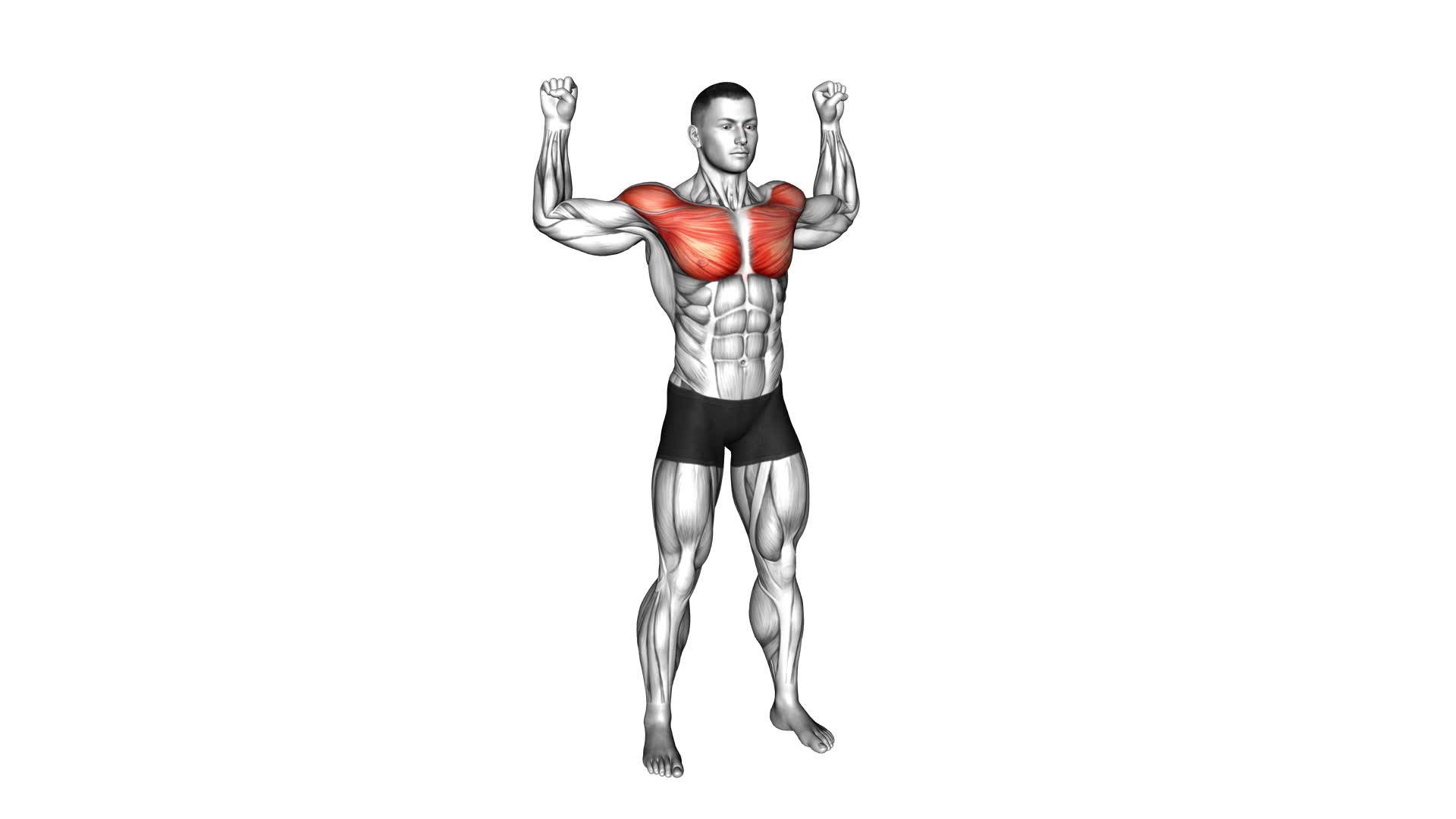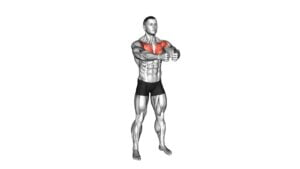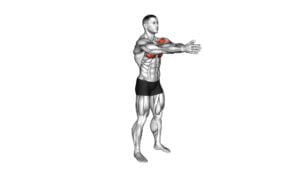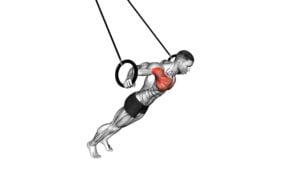Half Chest Fly (male) – Video Exercise Guide & Tips

Are you looking to sculpt a strong and defined chest? Look no further than the half chest fly exercise. In this video exercise guide, we'll show you how to properly perform this effective exercise, targeting your pectoral muscles.
Watch This Exercise Video
Whether you're a beginner or advanced fitness enthusiast, we have tips and modifications to suit your needs. Avoid common mistakes and maximize your chest workout with this dynamic exercise.
Get ready to take your chest workout to the next level.
Key Takeaways
- The half chest fly targets the pectoralis major and minor muscles, helping to sculpt a strong and defined chest.
- It can be modified for different fitness levels and improves chest strength and size.
- The exercise also engages the anterior deltoids and triceps to a lesser extent, enhancing overall upper body strength.
- Individuals with shoulder issues should consult with a healthcare professional before attempting the exercise, and alternative exercises such as dumbbell bench press, push-ups, and cable chest flyes can be effective alternatives.
Benefits of the Half Chest Fly
To maximize your chest development, incorporate the Half Chest Fly into your workout routine. The Half Chest Fly is a highly effective exercise that targets the chest muscles, specifically the pectoralis major and minor. It's important to perform this exercise with proper technique to ensure optimal results and prevent injury.
When performing the Half Chest Fly, it's crucial to focus on maintaining proper form. Start by lying on a flat bench with your feet flat on the ground and your back pressed firmly against the bench. Hold a dumbbell in each hand, with your palms facing each other and your arms extended straight above your chest. Slowly lower the dumbbells out to the sides in a controlled manner, feeling a stretch in your chest muscles. Then, return the dumbbells to the starting position by squeezing your chest muscles and bringing the weights back together.
As you progress in the Half Chest Fly exercise, you can increase the weight of the dumbbells or perform more repetitions. Gradually increasing the intensity will challenge your chest muscles and promote further growth and strength development. Remember to always listen to your body and adjust the weight and repetitions accordingly to avoid overexertion and potential injury.
Incorporating the Half Chest Fly into your workout routine with proper technique and progression will help you achieve a stronger and more defined chest.
Proper Form and Technique for the Exercise
To perform the Half Chest Fly exercise with proper form and technique, position yourself on a flat bench with your feet firmly planted on the ground and your back pressed against the bench. Hold a dumbbell in each hand, with your palms facing each other. Start with your arms fully extended above your chest, keeping a slight bend in your elbows.
As you lower the dumbbells, open your arms out to the sides in a wide arc until you feel a stretch in your chest. Keep your elbows slightly bent throughout the movement to avoid putting excessive stress on your shoulder joints. Pause for a moment at the bottom of the movement, then reverse the motion by squeezing your chest muscles to bring the dumbbells back to the starting position.
Maintain a slow and controlled movement throughout the exercise, focusing on engaging your chest muscles. It's important to avoid using momentum or swinging your arms, as this can diminish the effectiveness of the exercise and increase the risk of injury.
The Half Chest Fly exercise primarily targets the pectoralis major, the main muscle of the chest. It also engages the anterior deltoids and the triceps to a lesser extent.
While the Half Chest Fly can be beneficial for developing chest strength and size, it does have some limitations. One of the cons is that it may not be suitable for individuals with shoulder issues, as it places stress on the shoulder joint. It's important to consult with a healthcare professional before attempting this exercise if you have any pre-existing shoulder conditions.
If the Half Chest Fly isn't suitable for you, there are alternative exercises that can target the chest muscles effectively. Some alternatives include the traditional dumbbell bench press, push-ups, or cable chest flyes. These exercises provide similar benefits and can be modified to accommodate different fitness levels. Remember to always prioritize proper form and technique to maximize the effectiveness of your workouts and minimize the risk of injury.
Equipment Needed for the Half Chest Fly
You will need a pair of dumbbells to perform the Half Chest Fly exercise. The dumbbell weight you choose should be challenging but manageable for your fitness level. It's important to select a weight that allows you to maintain proper form throughout the exercise without straining your muscles or compromising your technique.
In addition to dumbbells, you'll also need a bench for proper positioning during the Half Chest Fly. Position the bench in a way that allows you to lie flat on your back with your feet planted firmly on the ground. This will provide stability and support for your body throughout the exercise.
When performing the Half Chest Fly, ensure that your dumbbells are held directly above your chest with your palms facing each other. Keep a slight bend in your elbows as you lower the dumbbells out to the sides, maintaining control and feeling the stretch in your chest muscles. Remember to exhale as you bring the dumbbells back up to the starting position, focusing on squeezing your chest muscles together.
Modifications and Variations for Different Fitness Levels
For different fitness levels, there are various modifications and variations that can be implemented in the Half Chest Fly exercise to cater to individual needs and abilities. Whether you're a beginner or an advanced fitness enthusiast, these modifications and variations can help you progress and challenge yourself effectively.
Here are some modifications for beginners:
- Reduce the weight: Start with lighter dumbbells or resistance bands to build strength gradually.
- Decrease the range of motion: Instead of bringing your arms all the way out to the sides, focus on a smaller range of motion to avoid strain.
- Perform the exercise on a stability ball: This will provide additional support and stability as you work on building strength in your chest muscles.
On the other hand, for advanced variations, you can try:
- Incline or decline chest fly: Perform the exercise on an incline or decline bench to target different angles of your chest muscles.
- Single-arm chest fly: Perform the exercise using one arm at a time to increase the challenge and engage your core muscles.
- Plyometric chest fly: Add a jump or explosive movement to the exercise to incorporate power and increase the intensity.
By incorporating these modifications and variations into your Half Chest Fly routine, you can tailor the exercise to your fitness level and continue to progress.
Now, let's move on to the next section to learn about common mistakes to avoid during the exercise.
Common Mistakes to Avoid During the Exercise
While performing the Half Chest Fly exercise, it's important to be aware of common mistakes that should be avoided in order to maximize effectiveness and prevent injury. By understanding these common mistakes and implementing proper technique tips, you can ensure that you're getting the most out of this exercise.
One common mistake to avoid is using too much weight. It can be tempting to go heavy, but using excessive weight can compromise your form and increase the risk of injury. Start with a weight that allows you to maintain proper form throughout the movement and gradually increase the weight as you become more comfortable.
Another mistake is allowing your elbows to drop too low during the exercise. This can put unnecessary strain on your shoulders and reduce the effectiveness of the exercise. Keep your elbows slightly bent and in line with your shoulders throughout the movement.
Additionally, avoid rushing through the exercise. Performing the Half Chest Fly with controlled and deliberate movements will engage your chest muscles more effectively. Take your time and focus on the mind-muscle connection to get the most out of each repetition.
Lastly, remember to breathe properly throughout the exercise. Holding your breath can increase tension in your muscles and compromise your form. Inhale as you lower the weights and exhale as you bring them back up.
Tips for Maximizing Your Chest Workout With the Half Chest Fly
To maximize your chest workout with the Half Chest Fly, it's important to focus on proper form techniques and muscle activation cues.
Maintaining proper form, such as keeping your back straight and shoulders down, will ensure that you're targeting the chest muscles effectively.
Additionally, engaging the chest muscles throughout the entire range of motion by squeezing them together at the midpoint of the exercise will help to maximize the benefits of the Half Chest Fly.
Proper Form Techniques
To maximize your chest workout with the Half Chest Fly, it's important that you focus on maintaining proper form techniques. Here are three tips to help you achieve optimal results:
- Avoid common mistakes:
- One common mistake is using too much weight, which can compromise your form and lead to injury. Start with a lighter weight and gradually increase as you become more comfortable.
- Another mistake isn't fully extending your arms during the exercise. Make sure to straighten your arms completely to fully activate your chest muscles.
- Lastly, avoid swinging your body or using momentum to lift the weights. This takes away the focus from your chest and reduces the effectiveness of the exercise.
- Engage your chest muscles:
Throughout the movement, consciously focus on squeezing your chest muscles. This will ensure maximum muscle activation and help you get the most out of each rep.
- Maintain proper posture:
Keep your back flat against the bench, shoulders relaxed, and feet firmly planted on the ground. This will provide a stable base and allow you to maintain proper form throughout the exercise.
Muscle Activation Cues
Focus on activating your chest muscles to maximize your chest workout with the Half Chest Fly. Muscle activation techniques can help you get the most out of this exercise and ensure that you're effectively targeting your chest muscles.
To activate your chest muscles during the Half Chest Fly, start by maintaining a slight bend in your elbows throughout the movement. This will help to engage your chest muscles and prevent excessive strain on your shoulder joints.
Additionally, focus on squeezing your chest muscles together as you bring your arms together in front of you. This contraction will further activate your chest muscles and enhance the effectiveness of the exercise.
Frequently Asked Questions
How Many Sets and Reps Should I Do for the Half Chest Fly Exercise?
For the half chest fly exercise, you should aim for a specific number of sets and reps to get the most out of your workout. However, without the context of the exercise guide and tips, it's difficult to provide a precise answer.
It's important to maintain proper form and technique to avoid injury and maximize results. Additionally, variations and modifications can be made to accommodate different fitness levels.
Always consult with a fitness professional to determine the appropriate sets and reps for your specific needs.
Can Women Also Perform the Half Chest Fly Exercise?
Yes, women can also perform the half chest fly exercise. It offers several benefits for women, including strengthening the chest muscles, improving posture, and enhancing upper body strength.
To modify the exercise for women, you can use lighter weights or resistance bands. Additionally, focus on proper form and technique to ensure effectiveness and prevent injury.
Incorporating the half chest fly into your workout routine can be a great addition to your overall fitness plan.
Is the Half Chest Fly a Suitable Exercise for Beginners?
The half chest fly is a suitable exercise for beginners. It helps to strengthen and tone your chest muscles. By performing variations of the half chest fly, you can target different areas of your chest and work on improving your upper body strength.
This exercise also engages your shoulders and triceps, providing a well-rounded upper body workout. Incorporating the half chest fly into your routine can yield great benefits, such as improved posture and enhanced overall upper body strength.
How Often Should I Include the Half Chest Fly Exercise in My Chest Workout Routine?
To get the most out of your chest workout, it's important to include the half chest fly exercise. This exercise targets the pec muscles, helping to build strength and definition in your chest.
As for how often to include it, aim for 2-3 times per week. This frequency will give your muscles enough time to recover while still allowing you to reap the benefits of the exercise.
Can the Half Chest Fly Exercise Help in Improving Posture?
The half chest fly exercise is a great way to improve your upper body strength and potentially help with posture. By targeting the chest muscles, this exercise can contribute to a stronger and more balanced upper body.
To get the most out of it, make sure to maintain proper form and try different variations to challenge your muscles in different ways. Incorporating the half chest fly into your routine can have numerous benefits for your overall fitness and posture.
Conclusion
In conclusion, the half chest fly is an effective exercise for targeting the chest muscles.
By maintaining proper form and using the appropriate equipment, you can maximize the benefits of this exercise.
It's important to avoid common mistakes and consider modifications for different fitness levels.
Incorporating the half chest fly into your chest workout routine can help you achieve a stronger and more defined chest.
Remember to consult with a fitness professional for personalized guidance.

Author
Years ago, the spark of my life’s passion ignited in my mind the moment I stepped into the local gym for the first time. The inaugural bead of perspiration, the initial endeavor, the very first surge of endorphins, and a sense of pride that washed over me post-workout marked the beginning of my deep-seated interest in strength sports, fitness, and sports nutrition. This very curiosity blossomed rapidly into a profound fascination, propelling me to earn a Master’s degree in Physical Education from the Academy of Physical Education in Krakow, followed by a Sports Manager diploma from the Jagiellonian University. My journey of growth led me to gain more specialized qualifications, such as being a certified personal trainer with a focus on sports dietetics, a lifeguard, and an instructor for wellness and corrective gymnastics. Theoretical knowledge paired seamlessly with practical experience, reinforcing my belief that the transformation of individuals under my guidance was also a reflection of my personal growth. This belief holds true even today. Each day, I strive to push the boundaries and explore new realms. These realms gently elevate me to greater heights. The unique combination of passion for my field and the continuous quest for growth fuels my drive to break new ground.







